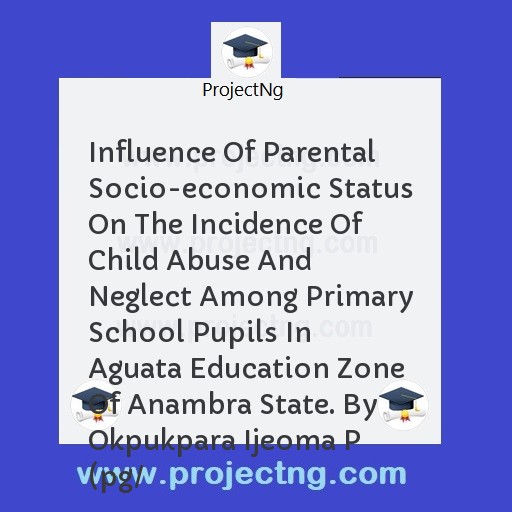Influence Of Parental Socio-economic Status On The Incidence Of Child Abuse And Neglect Among Primary School Pupils In Aguata Education Zone Of Anambra State. By Okpukpara Ijeoma P (pg/
Education Project Topics
Get the Complete Project Materials Now! »
INFLUENCE OF PARENTAL SOCIO-ECONOMIC STATUS ON THE
INCIDENCE OF CHILD ABUSE AND NEGLECT AMONG PRIMARY
SCHOOL PUPILS IN AGUATA EDUCATION ZONE OF ANAMBRA
STATE.
BY
OKPUKPARA IJEOMA P
(PG/
Abstract
The study sought to find out the influence of parental socio-economic status on
the incidence of child abuse and neglect among primary school pupils in Aguata
education zone of Anambra State. Three major attributes of socio-economic
status (parents’ income, parents’ education and parents’ occupation) were
considered. The study adopted Ex-post facto research design. Three research
questions and three hypotheses were formulated to guide the study. Sample
consisted of 618 primary six pupils drawn from schools in Aguata education
zone through simple random sampling. The instrument used for data collection
was parental socio-economic status and incidence of child abuse and neglect
questionnaire. The overall reliability coefficient of the instrument was found to
be 0.83. Data collected were analyzed using analysis of variance (ANOVA). The
finding of the study revealed that parents’ level of income significantly
influences the incidence of child abuse and neglect. It was also revealed that
parents’ level of education significantly influences the incidence of child abuse
and neglect. Furthermore, it was discovered that parent’s occupation
significantly influences the incidence of child abuse and neglect.
The implications of the findings were discussed and appropriate suggestions
and recommendations were made.
.
1
CHAPTER ONE
INTRODUCTION
Background of the Study
Procreation is a phenomenon that ensures the survival and continuity of a
nation. However, the rearing pattern of the children that are products of wedlock
is a crucial task that is significant in determining the quality of citizens that
make up a particular society. It is disappointing to note that juvenile cases and
other social vices that characterized our society today are traceable to bad child
patterns of many homes. Children who have passed through such homes were
either battered, abandoned, or abused in any other form. They were
consequently toughened and eventually become liabilities to the community
rather than assets. In Nigeria today, the rate of child abuse and neglect have
assumed a worrisome and alarming proportion (Semenitani, 1998).
Children are regarded as precious gifts from God. It is rather outrageous
and unfortunate that these same children are subject to abuse and neglect. Child
abuse and neglect is one of the most rampant societal malaise facing societies
today. The ill-treatment of children by those who are supposed to care for them
has been recognized as a major problem in child upbringing in the society.
Child abuse and neglect is a prevalent problem all over the world and Nigeria is
no exception.
.
2
There is no commonly accepted definition of child abuse and neglect.
Ohia, Soronnadi, Udemezue and Okonkwo, (2002) define child abuse and
neglect;
as a situation in which a child is suffering serious physical
injury, which was not inflicted upon him by accident, but by a
deliberate act or omission, is suffering harm by reason of
neglect, malnutrition or sexual abuse, is growing without
necessary and basic physical care, and is growing-up under
conditions, which threaten his physical and emotional
survival (P. 3).
According to Jones (1982), child abuse and neglect are seen as two
separate phenomenons. He defines child abuse as inflicting serious physical,
physiological and sexual injury on children through non accidental means,
while child neglect on the other hand is defined as endangering physical, mental
or emotional condition of children through improper care. Crystal (1995)
linking both child abuse and neglect, opined that child abuse may be physical,
sexual, emotional or through neglect. National Child Rights Implementation
Committee (NCRIC,1995) defines child abuse and neglect as any form of
cruelty to a child’s physical, moral or mental well-being. According to the
Department of Justice, Canada (2001), the term child abuse refers to the
violence, maltreatment or neglect that a child or adolescent may experience
while in the care of someone they either trust or depend on, such as parents,
siblings, other relatives caregivers or guardians.
Public Health Agency of Canada (2003) divided child abuse and neglect
into five categories, namely: physical abuse, sexual abuse, emotional abuse,
.
Be the First to Share On Social

Enjoying our content?
Don't miss out on new videos! Subscribe to our YouTube channel for more awesome content.
Subscribe Now!













